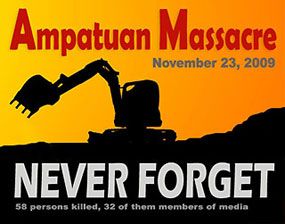Tuesday is the anniversary of the deadliest attack on the press ever recorded by CPJ. On November 23, 2009, 32 journalists and media workers were shot and killed in a massacre of 57 people in Ampatuan, in the southern province of Maguindanao. The victims were part of a convoy accompanying the supporters and relatives of a local politician filing candidacy papers in the provincial govenrnor’s race.
Gunmen allegedly commanded by Andal Ampatuan Jr., a local mayor whose powerful family controls much of the region, ambushed the group, executed them and dumped the bodies in open pits. One year later, amidst fears the perpetrators of this atrocity may escape justice, family, colleagues and media and human rights groups both in the Philippines and around the world are mobilizing to ensure the world remembers what happened.
Actions to mark this occasion include a candlelight march and benefit concert in Manila, a motorcade in Maguindanao to the site of the crime, and coordinated statements calling for justice. Also planned are a security training workshop for journalists in the Philippines and a public forum analyzing the role of the media, law, and politics in the massacre. A social networking campaign to raise awareness is under way as well. All events share the same message: Never forget and never again.
Below are a highlights of some events planned for the anniversary of the November 23 massacre and ways to get involved:
GET INVOLVED
Join the National Union of Journalists in the Philippines (NUJP)’s three-day social media campaign. NUJP asks media and concerned individuals to replace their profile pictures on Facebook with an icon depicting the fight for justice.
The International Federation of Journalists and the NUJP are organizing a Global Day of Action Against Impunity and for Justice to the Ampatuan Massacre Victims. The campaign suggests a wide array of actions that concerned organizations and individuals around the world can take, from letter-writing campaigns to collecting signatures in a condolence book for the victims’ friends and family.
Give financial help through CPJ’s Journalist Assistance Fund to surviving family members. Learn more about their struggle.
Photojournalists Jes Aznar and Froilan Gallardo present their multi-media exhibit “Beyond the Massacre” at the UP-CMC.
November 22:
In Manila, the Center for Media Freedom and Responsibility will announce winner of multimedia competition launched in September by the umbrella group Freedom Fund for Filipino Journalists. The winning project will be used in a national publicity campaign to raise awareness about the high rate of impunity in media killings.
“Never Forget,” a benefit concert featuring Noel Cabangon, Joey Ayala, and other Philippines artists will raise money to build a Memorial Shrine at the massacre.
November 23:
A torch parade Manila and simultaneous protest marches in at least 35 cities, led by NUJP chapters.
Families of the victims plan to participate in a motorcade starting in General Santos City and ending at the crime scene in Maguindanao. There will also be a memorial service in Maguindanao that day.
Frank La Rue, the U.N. special rapporteur for freedom of opinion and expression, will speak at Journalism Asia Forum 2010 in Manila, hosted by CMFR in cooperation with Southeast Asia Press Alliance (SEAPA).
LEARN MORE
Here is a selection of special reports and websites offering updated information and analysis on the Ampatuan cases:
Center for Media freedom & Responsibility and Philippine Center for Investigative Journalism regularly issue news and commentary on these and other cases of journalists killed.
CPJ’s special report, “Impunity on trial in the Philippines,” examines how bribes, intimidation, attacks, and compromised evidence threaten to undermine the government’s prosecution of dozens of suspects facing trial.
Human Rights Watch’s recent report, “They Own the People: The Ampatuans, State-Backed Militias, and Killings in the Southern Philippines” investigates a history of targeted killings, enforced disappearances, abductions, torture, and sexual assault in Maguindanao.
